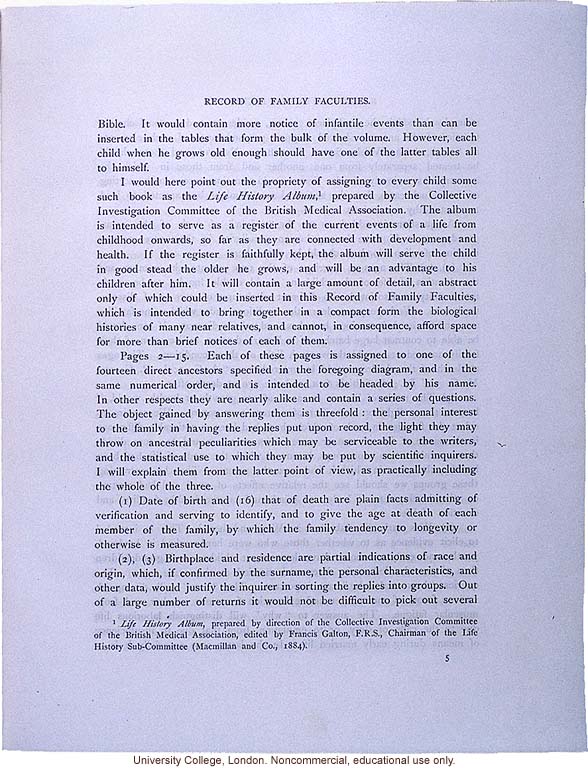Record of Family Faculties.
Bible. It would contain more notice of infantile events than can be inserted in the tables that form the bulk of the volume. However, each child when he grows old enough should have one of the latter tables all to himself.
I would here point out the propriety of assigning to every child some such book as the [italics]Life History Album,[superior 1][end italics] prepared by the Collective Investigation Committee of the British Medical Association. The album is intended to serve as a register of the current events of a life from childhood onwards, so far as they are connected with development and health. If the register is faithfully kept, the album will serve the child in good stead the older he grows, and will be an advantage to his children after him. It will contain a large amount of detail, an abstract only of which could be inserted in this Record of Family Faculties, which is intended to bring together in a compact form the biological histories of many near relatives, and cannot, in consequence, afford space for more than brief notices of each of them.
Pages 2-15. Each of these pages is assigned to one of the fourteen direct ancestors specified in the foregoing diagram, and in the same numerical order, and is intended to be headed by his name. In other respects they are nearly alike and contain a series of questions. In other respects they are nearly alike and contain a series of questions. The object gained by answering them is threefold: the personal interest to the family in having the replies put upon record, the light they may throw on ancestral peculiarities which may be serviceable to the writers, and the statistical use to which they may be put by scientific inquirers. I will explain them from the latter point of view, as practically including the whole of the three.
(1) Date of birth and (16) that of death are plain facts admitting of verification and serving to identify, and to give the age at death of each member of the family, by which the family tendency to longevity or otherwise is measured.
(2), (3) Birthplace and residence are partial indications of race and origin, which, if confirmed by the surnames, the personal characteristics, and other data, would justify the inquirer in sorting the replies into groups. Out of a large number of returns it would not be difficult to pick out several
[footnote superior 1][italics]Life History Album[end italics], prepared by direction of the Collective Investigation Committee of the British Medical Association, edited by Francis Galton, F.R.S., Chairman of the Life History Sub-Committee (Macmillan and Co., 1884).
[end]


